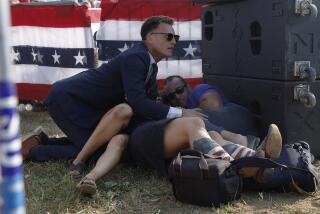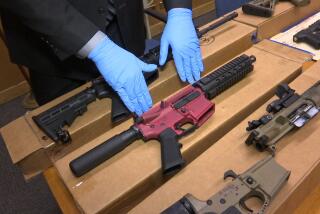Granada Hills Attack Renews Debate on Access to Guns
- Share via
They skulk on the dank fringes of every society--the fanatic, the disgruntled and the merely deranged.
Their rage always seems to have a caliber, and the intensity of this month’s grievance is measured in rounds per minute.
Today, there are 192 million privately owned firearms in the United States, according to the Washington-based Center to Prevent Handgun Violence. Nearly 2 million of them are so-called military-style assault weapons similar to the one employed by the gunman who attacked the North Valley Jewish Community Center on Tuesday. The latter sort of weapon seems to exert an inexorable attraction to the unstable.
So, too, apparently do schools.
The atrocity at the Granada Hills preschool and summer camp was the ninth school shooting to occur in America over the past two years. The violence ricocheted from Pearl, Miss., to Paducah, Ky., to Jonesboro, Ark., to Edinboro, Pa., to Fayetteville, Tenn., to Springfield, Ore., to Littleton, Colo., to Conyers, Ga., to the San Fernando Valley.
And the body count has mounted: Since 1997, gunmen of all ages with motives ranging from the impenetrable to the pathetic have killed 27 children and adults and wounded 78 more at schools.
One hundred forty-seven Americans died in the Gulf War.
Like the other mass shootings committed in California over the last 15 years, Tuesday’s attack involved a high-caliber, rapid-firing assault weapon with a high-volume detachable magazine. A Fire Department official said paramedics who initially arrived on the scene counted more than 50 empty 9-millimeter shell casings on the floor of the community center. That total, combined with descriptions of the weapon given police and reporters by eyewitnesses, suggests that the gunman was armed with an automatic version of either the Israeli-made Uzi or the American-manufactured Mac 10. They have similar sizes and profiles--and equally deadly histories.
Uzi Has a Deadly History
An Uzi was one of the weapons used by the unemployed security guard who shot 21 people to death and wounded 17 others at a McDonald’s restaurant in San Diego in 1984. Five years later both the Uzi and Mac 10 were among the 60 assault weapons whose sale California banned after a gunman armed with an AK-47 murdered five Southeast Asian schoolchildren at play in a Stockton schoolyard. Also proscribed was the TEC-9 used by a disgruntled client to kill eight people and wound six in a San Francisco law office in 1993.
Though banned in California under the Roos-Roberti Act of 1989, all three guns remain easily available in neighboring states.
For example, used Israeli Uzis, as well as clones manufactured in Croatia and China, are still frequently sold in Nevada. A used Uzi typically sells for more than $1,000, while U.S.-made copycats sell for about $500, according to John Salaza of Discount Firearms in Henderson, Nev. Uzi replicas such as the Ingram Mac-10 sold new for about $250 before 1994, when the federal government banned their manufacture, Salaza said.
“Gun violence is the scourge of our county, and something has to be done about it,” Los Angeles County Supervisor Zev Yaroslavsky said at a news conference after Tuesday’s shootings. In an interview later in the day, he said that “access to semiautomatic and fully automatic weapons, like the one that apparently was used at the community center, has reached epidemic proportions in this country.
“To our disgrace, one of the places where they are most easily accessible is our own Los Angeles County Fairgrounds, where the biggest gun show in the county occurs four times a year,” Yaroslavsky said. “Assault weapons--semiautomatic and automatic, all of them illegal--are sold at every one of those shows along with enough hate literature to turn the place into a cesspool. It’s time to shut it down,” he added, pledging that he will demand that the gun show operator’s contract be terminated.
Chuck Michel, a Los Angeles lawyer for the National Rifle Assn., which opposes further restrictions on gun shows, declined Tuesday to engage in debate about guns.
“The only appropriate comment at this time is one of sympathy for the victims and the sincere hope that the perpetrator pays a terrible price for this terrible act,” he said.
But former Assemblyman Mike Roos, coauthor of California’s assault weapons ban, said: “There are more gun dealers in America than gas stations. It’s crazy. With so many troubled people out there it’s almost as if God is looking out for us because we don’t have more killings.”
Roos said that courts have upheld state efforts to control guns but that lawmakers have been timid in trying to strengthen them.
“Legislatures have outlawed brass knuckles. They have outlawed lawn darts,” he said. “Should we allow the free flow of weapons to the degree that if you have enough money, you can buy them almost as easily as chewing gum?”
In fact, Monte Buchsbaum, an expert in biological psychiatry at the Mt. Sinai School of Medicine in New York, said random mass violence typically entails not only aggressiveness but also mentally disordered thinking and access to powerful weapons.
The empirical observation found a moral echo in the mind of one rabbi. “This was a visible and despicable crime, to target children, in and of itself,” said Rabbi Steven Jacobs of Temple Kol Tikvah in Woodland Hills. “I’m not so quick to call it a hate crime. This may have been just another crazy person with a gun.”
*
Times staff writer Terence Monmaney contributed to this story.
More to Read
Sign up for Essential California
The most important California stories and recommendations in your inbox every morning.
You may occasionally receive promotional content from the Los Angeles Times.










